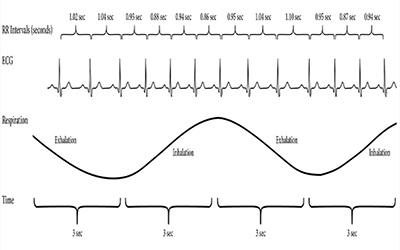Physiology of the spirit
Spirit is an important driver in life and has great impact on health and performance.
By:
Spirit - Spiritual Care
-
7/10/2017
-
Page Image 1
-
Page Image 2
-
Slider Image
Page Content
The spirit is an important driver in life and has a great impact on health and performance. But how can you tell if you are spiritually healthy or how much "spirit" you have? Most spiritual assessments involve perception-based surveys or questions about whether or not someone has faith, involvement in a religious community, spiritual practices, or the level of spiritual factors such as gratitude, love, peace, and hope. These are helpful, but what if there were a way to actually measure the physiology of the spirit and how it affects your body's resources?
To many people the spirit seems abstract and mysterious. It's like the wind. You can't see where it comes from or where it's going. However, you can feel its effect and measure its direction and speed.

There might not be a direct spiritual measurement for the body—such as temperature, blood pressure, or cholesterol levels—at this point in time, but there is a way to see the impact of the relationship between the spirit and the body.
The autonomic nervous system manages important functions—such as heartbeat, blood pressure, breathing, and digestion—that you do not regularly control using conscious thought. Your nervous system is always active to help your body adjust to both the internal and external demands of life.
Heart rate variability (HRV) is a reliable index of autonomic function and a window to understanding the physiology of the soul. HRV is a measure of the amount of change or variability between heartbeats. This seems counterintuitive. Most people think that the heart beats in a metronome-like fashion at exactly the same interval between beats. However, the heart slows down when you exhale and speeds up when you inhale. The graph below is a representation of an electrocardiogram (ECG) measurement over 12 seconds.

Notice the difference in the time intervals between the peaks in the ECG wave. They actually vary between beats (1.20 seconds, 1.40s, .93s, .83s etc.). The heart constantly changes in conjunction with other systems to help your body adjust to different stress levels and demands.
So what do these changes between heartbeats have to do with health, spirit, and performance? It turns out that when the variability between heartbeats is chronically low, people tend to be exhausted and are at greater risk to experience burnout, illness, and injuries. On the other hand, high HRV is a sign of increased energy, adaptability, resilience, and overall capacity for health and performance.
HRV is similar to the gas mileage of a car. Miles per gallon is an overall measure of how a car responds to driving conditions. Low gas mileage could come from a combination of factors such as road conditions, driving habits, dirty spark plugs, clogged air filter, low tire pressure, bad gas, etc. Like performance in a car, HRV is affected by a significant number of factors.
However, it is a good overall measure of how your body is responding to life demands, and that is why elite athletes rely on it to optimize training and readiness. Even though HRV is not used to diagnose disease or specific conditions, it is an extremely useful guide to understanding overall function, energy, and spirit. The level and quality of HRV is reflected in one's spirit and body resources. When long-term HRV is low, it can be a sign that the spirit is weary, downcast, and disheartened.
Someone with long-term high HRV tends to be rich in spirit, energized, enthusiastic, and determined when faced with adversity. Managing body resources is important to well-being, and HRV is a tool to increase awareness around what renews and strengthens life energy and spirit.
Physiology of the spirit.aspx
Related Articles

